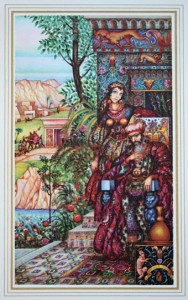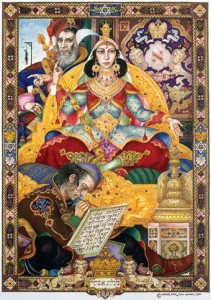Holidays
Purim
The Arts: Arthur Szyk and His Books of Esther

Le Livre d’Esther. Paris, 1925
Reproduced with the cooperation of
The Arthur Szyk Society, www.szyk.org
Political activist Arthur Szyk interpreted the Book of Esther as one who was a witness to history and fighter for justice.
Renowned artist and political cartoonist Arthur Szyk illustrated the Book of Esther twice, once in the 1920s, and again in 1950, one year before he died. From the beginning to the end of his career, the Polish-born Szyk (b. Lodz, 1894) loved the heroes and heroines of biblical tales. Because he understood what it meant for the few, the proud, to stand up to the many, he ultimately dedicated his life to fighting as a self-described “soldier in art” against the might of the modern-day Hamans and Holoferneses who threatened Jewish survival.
While Szyk’s two versions of the Book of Esther are different in style and technique, their message is the same. Szyk’s illustrations are visual commentary on the biblical narrative as well as the unfolding events of the day. In both books, he serves as a witness to history, one who responds to injustice in his own time—with action, not pity! Szyk’s Le Livre d’Esther was published in Paris in 1925, while Russian and Eastern European anti-Semitism spread across Europe; Szyk’s second Book of Esther (published posthumously in Israel in 1974) was illustrated in New England post-World War II, after the horrors of Nazism were evident to the world. In the first work, Szyk emphasized the beautiful Esther’s ability to inhabit two cultures and stay true to her people. For example, in “Esther and Mordechai” (1925), Esther’s fashionable costume and hairstyle show her full participation in Persian culture, even while her attention to her cousin Mordechai shows her loyalty to family and faith. In the later work, Szyk painted swastikas on the wicked Haman, affirming the need to confront evil in every place and every generation. In the illumination where Haman hangs from the gallows that he had prepared for Mordechai, Szyk painted himself into the work observing the scene, with hamantaschen in hand, while inscribing the Hebrew words: “The people of Israel will be liberated from their persecutors.” The image “Queen Esther and Mordechai” (1950) reminds the viewer how that liberation was won: Esther sits in triumph, having navigated political intrigue and cultural hatred to secure her people’s sovereignty.

The Book of Esther. New Canaan, 1950.
(Original art: Sussi Collection, Chicago.)
Reproduced with the cooperation of
The Arthur Szyk Society, www.szyk.org .
Through the Book of Esther, Szyk teaches that, with proper vigilance, the Jewish people will triumph over those who rise up against them, their Esthers showing a beauty and strength of character that will inspire Jews living in every age.
Irvin Ungar is founder and chief executive officer of Historicana. For more information about Arthur Szyk, visitwww.szyk.com.
Reproduced with the cooperation of The Arthur Szyk Society, Burlingame, California, www.szyk.org.










 Facebook
Facebook Instagram
Instagram Twitter
Twitter
Emmerson says
Hi, I’m doing an SOR assignment on the Book of Esther and found you source extremely helpful and was wondering if you knew of any other sources relevant to the description of this particular piece of artwork?